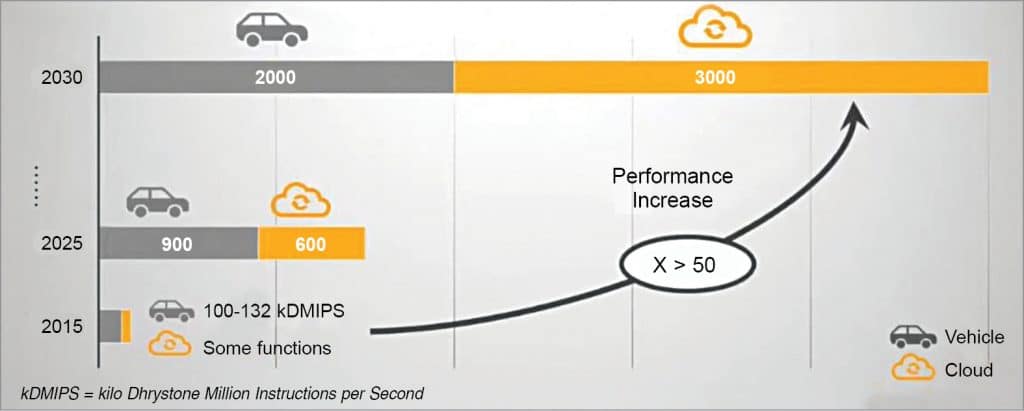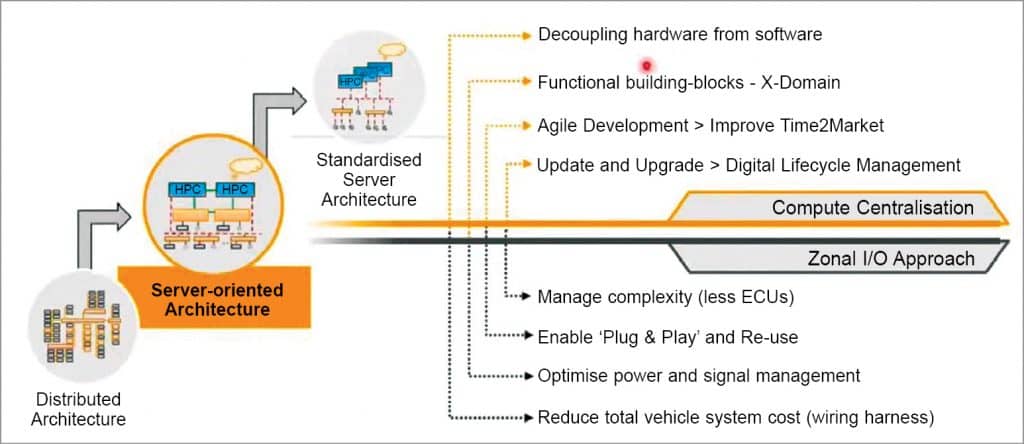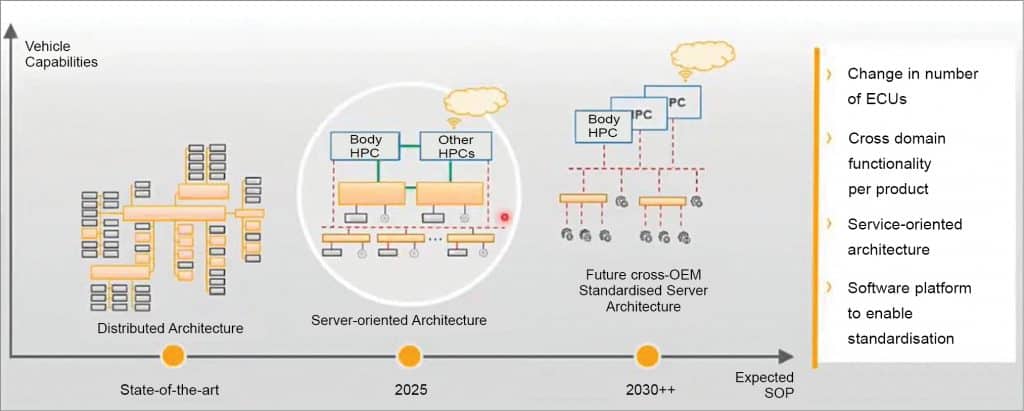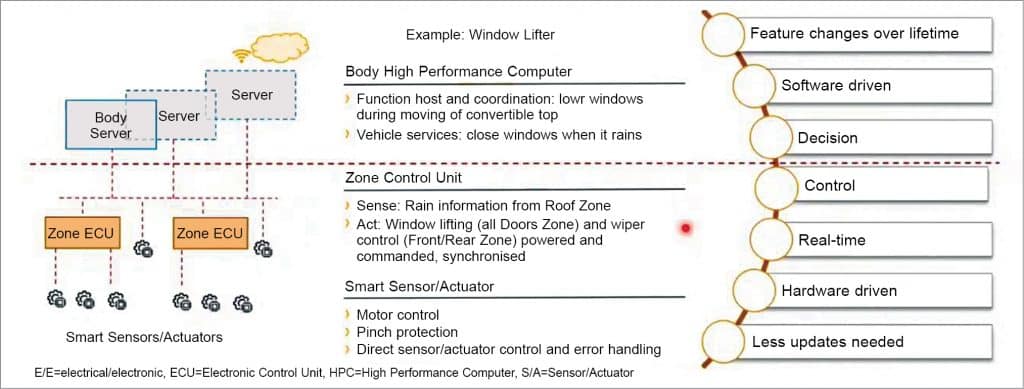Smart mobility will change the way we commute, and with this the hardware and software associated with the vehicle will also revolutionise. Here is an expert opinion on how the automotive trends will affect the vehicle architecture.
Automotive technologies are consistently progressing. Technologies for connected mobility and its infrastructure are already hitting the market. With these advancements, there is going to be an ever-growing need for computation power inside the vehicle and the cost will grow exponentially. To tackle this challenge, there is a need for newer vehicle architecture that can handle data and functions with minimum control units.
In this article, we will look at some trends in the automotive industry that are emerging with recent technologies, and how improved vehicle architecture can cater to all the recent requirements.

Trends revolutionising the architecture
We are all aware of the recent advancements in automotive industry, which are only going to improve further. So, technologies inside a car, its architecture, and the electronic control units (ECUs) have all to be aligned for this radical shift in the way we commute.
Besides, we know that alternative drives are taking over, and we are going beyond the traditional combustion engines. We are looking at alternate ways that could make our mobility sustainable and also leave less carbon footprints in the environment. This is influencing the way the technologies in vehicles are being imagined today.
Cloud services are an indispensable part of connected vehicles to pull-in necessary software and updates directly without interference. With connectivity, a vehicle and its architecture would be a part of the mobility ecosystem. The automotive technology has so far lagged behind and has to catch up and be prepared for the IoT revolution happening in the ecosystem.
We are in the era of tablets and smartphones where you can get new applications and services with the tap of a button. The software interface harnesses the powerful hardware and gives you a totally new experience. The same would go with respect to cars.
We are racing towards software-defined vehicles as a result of the ongoing transformation of the automobile from a product that is mainly hardware based to a software-centric device on wheels. With the advancements, we are slowly reaching towards better-performing and smart automotive technologies.
As a result, the vehicle cost will increase, and hence leaving that asset unutilised in a parking lot would not be sustainable. This is behind the increasing popularity of shared mobility; the business model of owning vehicles will change. The automotive industry has to adapt to these changes that will happen in various aspects of mobility.

Impact of market trends
With the established market trends such as these, we move towards understanding what they mean. If you look inside a connected electric vehicle, you will observe 10-20 times increase in the software required. The increase is required to cater to those trends. We need to connect with the outside to keep up with the fast changing environment and take actions istantaneously.
Connectivity also brings the challenge of cyber security. Earlier, the data links were contained inside the vehicle itself, but now everything is going to be exposed on the cloud based infrastructure. Instances like hacking, data manipulation, theft, etc are natural consequences of this connected mobility. It is therefore important to ensure that everything is up to date in the infrastructure and give protection to the users.
With increased complexity in software architecture, need for upgrading the ECUs and other functions, new business models are required where the products will merge. Startups will play an important role here.
Moreover, we are now moving towards improved architecture where we will need around twenty million lines of code for software development. For implementing parallel development, startups will come in to provide that extra fuel for us to go forward.
With increased complexity in software architecture, need for upgrading the ECUs and other functions, new business models are required where the products will merge. Startups will play an important role here.
Recent advancements and market trends have made a big impact on vehicle architecture. To cater to all our requirements, vehicles will contain more ECUs, and the computations will increase. Then, with all this movement of data, it is important not to compromise on the real-time reactions that are required. A little compromise can be done on infotainment systems’ data responses (not at the cost of user experience), but high priority functions need to be responded to as quickly as possible.
With all these advancements and trends, the cost and the complexity of the vehicle architecture will continue to grow exponentially. Therefore, there is certainly a need to optimise change or upgradation of the vehicle architecture to cater to all these needs. As cost of the vehicle will be going up, the industry needs to ensure that the vehicle stays relevant.

Architecture trends
In simple terms, there is going to be a big computational revolution. Going forward, we will see a big increase in computational power inside the car, as well as in terms of cloud service. To deliver such computational performance, we are looking at 50 times the performance needed from the vehicle architecture as of now. With this computational revolution, we are talking about a complete shift in the way we will implement and design vehicle architecture.
Talking about today’s vehicles, every ECU works for itself and shares only necessary information with other ECUs. Moreover, it is a closed system, which means one cannot upgrade the software and other aspects. Going forward, we are going to witness a big change where a central ECU will be able to decouple software from hardware.
Today, software is very much attached to the hardware such that the software cannot function in another hardware properly, or if there is any change in the hardware. This makes it inconvenient to upgrade hardware as one also needs to work closely on the software. We need to decouple hardware and software so that changes/modifications can be made in either of them independently.
With high computational complexity, there is a high chance we might bring in cross-domains like human-machine interface (HMI) and infotainment systems, which are basically different domains but will have to come together.
Further, central computation will be enabled in near future, which would reduce the number of ECUs. This, in turn, would reduce complexity, the interfaces, and the cost. And it would allow us to easily implement plug-and-play type of product development with decoupled hardware and software.
We can see this trend of zonal ECUs and central ECUs already, and many OEMs have already migrated to this kind of architecture. Talking about the time to market, we are still looking at about the same time or in fact reduced time.
Change in role of ECUs
With improved architecture, as discussed, the number of ECUs will come down and upgradability will improve. It is difficult to update an ECU and predict its impact on the ECUs at present.
With increased computational power, we will be able to introduce new features like cross-domain functions. The software platform will become standard and with that the merging product line will be supported with service oriented architecture. Then the location of function in the vehicle will no longer matter, as long as it is within the vehicle or is a part of the offboard function.
With all this, what are the things we will be able to address?
We will be able to update firmware over the air, so updating multiple ECUs will become easier. The associated data will come in the central ECU, which will help us in predictive diagnosis. Apart from this, there will be an increasing demand for virtualisation.
It is important that we have this support in the central ECU, so that we can support JAVA, Android, etc based applications in future with the available hardware. We have to make sure that the hardware is capable of doing such things and the software framework allows us to do it.
The challenge is to bring all this together on a state-of-the-art integration platform because, ultimately, the integration becomes a key factor for OEMs. They would like to have faster development as there will be multiple parties involved, who would have to be brought together with a robust integration platform.
There will be a central ECU acting as a brain or central processing unit, and there will be zonal ECUs for their respective zones. If we take the example of a window lifter, when there is rain the system would have to be smart enough to close the sun-roof, raise windows, and switch on the wiper without any user intervention.
There are two ways to achieve this kind of operation. Either the zonal controllers along with the smart sensors and actuators could do it, or the high-performance central ECU could decide and send signals, so that the zone controllers do their part. Based on various considerations, one can enable any of these two architectures.

The way forward
The current situation is like this: We have multiple ECUs that are connected but are doing their own part independently, exchanging information only when needed. Going forward, these ECUs will become bigger and faster. As mentioned, we will see central ECUs and zonal ECUs in architecture.
The question is whether to update all the ECUs or update just the central ECU? Updating each ECU is costly. To avoid this complexity and cost, we have to migrate to a revolutionary approach where only the central ECU is updated and the zonal ECUs stay put with current software.
Next step is to secure the integrated ecosystem. And securing systems within the vehicle only is not sufficient; securing the link between the vehicle and the cloud server is also important. Because advancements in software also lead to high vectors for others to exploit.
Within the vehicle, the ECUs need to be protected from tampering. There must be a system to detect vehicle anomalies and to alert when any kind of attack is happening. The architecture has to be built from ground up considering all these factors.
An example of all these integrations can be seen in Volkswagen ID.3 series (some vehicles have been launched and some are in the pipeline). Basically, in the past, more emphasis was put on the control units, the hardware, the services, and the functions provided. But now, with additional demands, security features have to be built-in as part of vehicle architecture.
Moreover, there must be options for the architecture to talk to the latest IoT devices. These additional demands cause the need for plugins to be already available in the central ECU, zonal ECUs, and other smaller control units.
Regarding connectivity with the cloud, the sensor data has to go through several layers before reaching the cloud and get processed. The sensor senses the data, the central computing device processes the sensed data and transmits it to the cloud. It can be clearly seen that the integration is vertical, therefore we call it vertical integration.
There is horizontal integration where there are multiple domains and third-party software. All of the components in horizontal integration must have plug and play type of product design, so that a particular function can be changed without affecting other components. This kind of integration becomes necessary going forward.
With integrations becoming a bigger aspect, we are talking about a complex system. In order to manage the complex system, there will be an increase in the number of people needed to execute the project. For a typical OEM in Tier 1 cities, this number will rise from 30 to 400. The number of parallel project deployments in an OEM will go up, and as a result the number of departments due to horizontal integration will go up, and so there will be multifold increase in stakeholders.
Further down the line, there will be a twenty-fold increase in the lines of code. Besides, the business model will change. What happens typically is that hardware gets delivered along with some software, but a portion of it or all of the application software may come from third-party vendors. Therefore, we are talking about less share of R&D, which is a clear departure from the past.
What’s important is to understand different business units, whether these are internal or external. We have to work together having synergies and establish something like central engineering, which could talk to different stakeholders and bring everything together.

Conclusion
To summarise, here is an actual example of the Volkswagen project that has been recently launched. We observed that there were 68 ECU links in the car. There were 20 protocols to talk to multiple stakeholders, and there were 19 companies aligned for this project. The stakeholders’ requirements jumped to around 70,000 and more. And then, in terms of volume of contribution, there were about 600 continental developers.
In order to bring together such an environment, project management has to play a key role. With architecture change, we are paving the road for better connected mobility and software defined vehicles.
The article is an extract from a speech delivered by Vinayaka Nagaraja, Head, Central Engineering – Systems Domain & Body Network Control, Vehicle Networking and Information (VNI), Continental Automotive India, at MOVES 2021. It has been prepared by Darshil Patel, a technology journalist at EFY.





